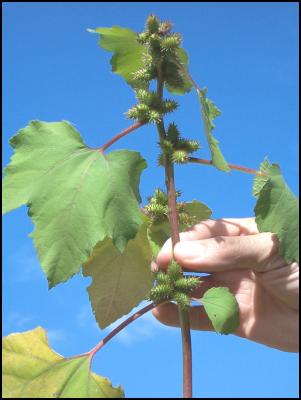Weed find sparks regional search
MEDIA RELEASE
Weed find sparks regional search
For immediate release: Thursday 27 April 2006
An extremely rare but toxic weed found growing in two paddocks near Tauranga has sparked a region-wide search and a call for help by Environment Bay of Plenty.
Until now, Noogoora bur (Xanthium strumarium) was thought practically eradicated in New Zealand. The plant, with its clingy hooked burs, has only had two officially recorded infestations over the past few decades. These were in Matamata and north of Wellington. It has never been found in the Bay of Plenty before.
Environment Bay of Plenty staff are now investigating two independent infestations discovered in the same week but located several kilometres apart.
Pest plant coordinator John Mather says the weed must not be allowed to take hold in the Bay of Plenty. “We are asking people to look out for it and call us if they think they’ve seen this plant,” he says.
Noogoora bur is an erect, summer growing annual that usually grows to about one and a half metres high, though it can grow to three metres high. It can grow as a plant with an erect single stem or as a much-branched spreading plant. It has a different leaf shape and grows far higher than the relatively common Bathurst bur. At seedling stage, its leaves are toxic to most livestock. It can cause contact allergy and dermatitis to both humans and animals.
A Papamoa maize grower reported the first incident early in April. He wanted advice on a difficult to control weed scattered through his 4ha maize field, Mr Mather says. The grower initially thought it was the closely related Bathurst bur. That same week, regional council staff discovered a smaller infestation of 12 plants alongside another maize field in Bethlehem.
Environment Bay of Plenty staff immediately implemented a management plan, inspecting adjacent properties and nearby drains at both locations. They hand-removed and incinerated the Bethlehem plants and are now doing the same for those growing at the larger site. Mr Mather has also tracked the maize harvested from both fields to ensure the weed does not spread further. This work has involved Environment Waikato, which will inspect a maize company depot near Hamilton as well as their local landfill. “It is vital that we do not allow this weed to get away from us,” Mr Mather says.
Mr Mather says the infestations involve different maize growers and appear to be unrelated. “It has been a very unusual coincidence. We will also investigate the source of the maize seed, especially that imported from overseas.” He asks people who may have seen Noogoora bur to call him on 0800 ENV BOP (368 267).

Click for big version
Have you seen this weed? Noogoora bur has burs with hooked spines, which cling firmly to wool or fur, bags and clothing.
ENDS


 Gordon Campbell: On The Hikoi Aftermath
Gordon Campbell: On The Hikoi Aftermath Stats NZ: National Population Estimates: At 30 September 2024 (2018-base)
Stats NZ: National Population Estimates: At 30 September 2024 (2018-base) NZ Government: New Zealand’s COP29 National Statement
NZ Government: New Zealand’s COP29 National Statement Surf Life Saving NZ: Volunteer Lifeguards Make Big Effort To Keep Us Safe, As Paid Lifeguard Service Commences In Northern Region
Surf Life Saving NZ: Volunteer Lifeguards Make Big Effort To Keep Us Safe, As Paid Lifeguard Service Commences In Northern Region Action Station: Biggest Ever Community Petition, With Over 200,000 Signatures, Opposes Treaty Principles Bill
Action Station: Biggest Ever Community Petition, With Over 200,000 Signatures, Opposes Treaty Principles Bill Palestinians for Hīkoi mō te Tiriti: Statement From Palestinian Leaders - Hīkoi Mō Te Tiriti Is A Historic Moment For All In Aotearoa
Palestinians for Hīkoi mō te Tiriti: Statement From Palestinian Leaders - Hīkoi Mō Te Tiriti Is A Historic Moment For All In Aotearoa Anglican Church in Aotearoa: Anglican Archbishops To Join Hīkoi Mō Te Tiriti In Wellington
Anglican Church in Aotearoa: Anglican Archbishops To Join Hīkoi Mō Te Tiriti In Wellington


